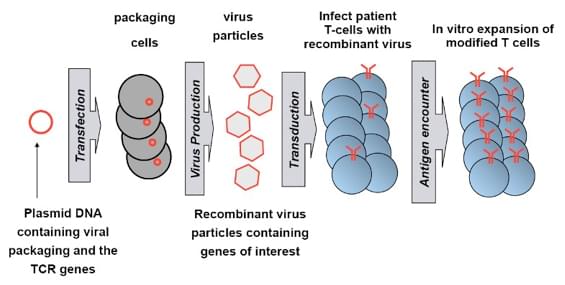All products and services are For Research Use Only and CANNOT be used in the treatment or diagnosis of disease.
Creative Biolabs develops various popular strategies to transfer TCR genes into T cells, one of which is mediated via retrovirus. With its high infection efficiency, stable recombinant gene expression ability and low immunogenicity, retroviruses have become the first choice in gene therapy researches, including some FDA-approved clinic trials. Our retrovirus-mediated TCR gene transfer solution consists of the construction of plasmid containing TCR gene, the generation of recombinant retroviruses and the production of virus particles with packing cells and the transduction TCR gene into T cells. Retroviruses infect target cells by binding of the viral envelope protein to cell surface receptors.

Figure: Retroviral gene transfer to generate tumor-specific T cells
Retroviruses can be found in almost all animals including chickens, mice, goats, primate, humans and fish. In clinical gene therapy, retroviral vectors are one of the most preferred transfer systems. Up to date, vectors derived from gamma-retroviruses such as murine leukemia viruses (MLVs) have been widely used for gene transfer into human T cells. Retroviral viral DNA can be stably incorporated into host genome and propagated in daughter cells, so retroviral vectors are appropriate tools to perform long-term expression of the transgene, achieving therapeutic efficacy. After entering host cells, the single-stranded RNA genome of retroviruses is released into the cytoplasm and converted into a double-stranded DNA by virus-encoded reverse transcriptase. Followed by which, the viral DNA forms pre-integration complex, a large nucleoprotein structure containing proteins which are important for nuclear localization and facilitate to insert viral DNA into the host genome. One of the most important barriers during the use of retrovirus vectors is they are unable to transduce nonproliferating target cells, while in many gene therapy protocols, target cells such as T cells are quiescent and induction of cell proliferation is to be avoided. Now, improved retroviral systems including retrovirus packing cells and vector components have been researched and developed to express cloning and functional genomics.
The most popular strategies used for TCR gene transfer:
| ➤ | Viral vectors: |
Retrovirus-mediated TCR Gene Transfer Lentivirus-mediated TCR Gene Transfer |
| ➤ | Electroporation |
References:
To discuss your demands or to request a proposal, please contact us by .
For any technical issues or product/service related questions, please leave your information below. Our team will contact you soon.
 NEWSLETTER
NEWSLETTER
The latest newsletter to introduce the latest breaking information, our site updates, field and other scientific news, important events, and insights from industry leaders
LEARN MORE NEWSLETTER NEW SOLUTION
NEW SOLUTION
CellRapeutics™ In Vivo Cell Engineering: One-stop in vivo T/B/NK cell and macrophage engineering services covering vectors construction to function verification.
LEARN MORE SOLUTION NOVEL TECHNOLOGY
NOVEL TECHNOLOGY
Silence™ CAR-T Cell: A novel platform to enhance CAR-T cell immunotherapy by combining RNAi technology to suppress genes that may impede CAR functionality.
LEARN MORE NOVEL TECHNOLOGY NEW SOLUTION
NEW SOLUTION
Canine CAR-T Therapy Development: From early target discovery, CAR design and construction, cell culture, and transfection, to in vitro and in vivo function validation.
LEARN MORE SOLUTION